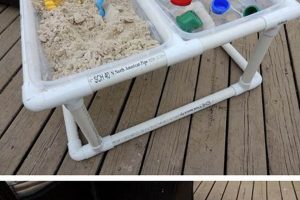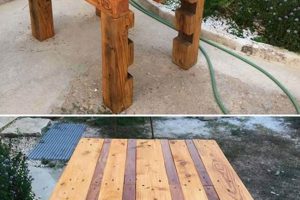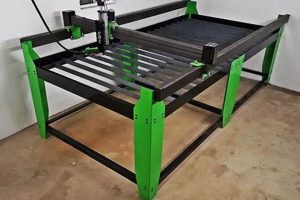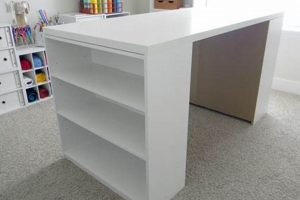The act of creating a safety device designed to guide wood through a table saw, protecting the user’s hands from the blade, is the core concept. This typically involves crafting a wooden or plastic tool with a handle that allows for controlled pressure and movement of the workpiece during cutting operations. An example is constructing a simple rectangular block with a handle on top and a high-friction surface on the bottom.
Such projects offer several advantages. Primarily, they enhance safety in the workshop by maintaining a safe distance between the operator’s hands and the spinning blade. This reduces the risk of injury. Additionally, self-made versions can be customized to specific needs and preferences, offering a tailored solution that may not be available commercially. Historically, woodworkers have often fashioned their own jigs and fixtures, demonstrating a tradition of resourceful problem-solving and adaptation within the craft.
The following sections will explore different designs, materials, construction techniques, and safety considerations relevant to building these essential shop aids. Factors like grip, durability, and suitability for various cutting tasks will be examined to provide a comprehensive guide for those interested in creating their own.
Construction Guidance
The following recommendations aim to optimize the process of fabricating a safety tool for table saw operation, prioritizing functionality and operator safety.
Tip 1: Material Selection. Opt for dense hardwood or durable plywood for the main body construction. These materials withstand pressure and resist splintering, contributing to longevity and reliability during use.
Tip 2: Handle Ergonomics. Prioritize a handle design that provides a secure and comfortable grip. The handle should be sized appropriately for the user’s hand and positioned to allow for firm downward pressure and forward motion.
Tip 3: Friction Enhancement. Apply a non-slip material, such as rubber or specialized adhesive grip tape, to the underside of the tool. This prevents slippage on the workpiece and enhances control during the cutting process.
Tip 4: Edge Angulation. Consider angling the leading edge of the tool to improve contact with the workpiece and minimize the risk of the tool catching on the blade. A slight bevel can enhance smooth and controlled feeding.
Tip 5: Dimensional Accuracy. Maintain precise dimensions during construction to ensure the tool functions effectively. Square cuts and accurate measurements are crucial for consistent performance and safety.
Tip 6: Regular Inspection. Routinely inspect the tool for signs of wear or damage, such as cracks, splinters, or loose components. Address any issues promptly to maintain its integrity and prevent accidents.
Tip 7: Design Variation for Specific Cuts. Consider creating different styles of tools for specific cutting tasks, such as thin strip cutting or angled cuts. Tailoring the tool to the application improves efficiency and safety.
Tip 8: Prioritize safety. Adhere to all relevant safety guidelines and best practices during table saw operation, regardless of the tool being used. The tool is an aid, not a replacement for proper technique and caution.
These recommendations emphasize careful planning, material selection, and construction techniques to create a reliable and effective tool. Implementing these suggestions contributes to a safer and more efficient woodworking experience.
The following section provides details on the tools required for this project.
1. Material Durability
Material durability is a primary consideration in designs for a table saw push block. The tool’s longevity and reliability are directly proportional to the strength and resilience of the materials used in its construction. A lack of durability in the selected material can lead to premature failure, compromising operator safety and negating the purpose of the device. The forces exerted during table saw operations, including friction and impact, demand robust materials capable of withstanding repeated use without degradation. For instance, using softwoods like pine or fir results in rapid wear and tear, particularly at contact points with the workpiece or the saw table. This can lead to splinters, cracks, or deformation, rendering the tool ineffective and potentially hazardous.
Conversely, employing hardwoods such as maple, oak, or Baltic birch plywood significantly enhances the lifespan and performance of the tool. These materials exhibit superior resistance to abrasion, impact, and moisture, ensuring the push block maintains its structural integrity over time. The choice of material also impacts the tool’s ability to transmit force effectively and maintain a consistent grip on the workpiece. A durable material is less likely to deform under pressure, allowing for more precise control and reducing the risk of slippage. The integration of durable, wear-resistant materials represents a proactive approach to safety and longevity in woodworking practices. This also can save you cost by buying other material on the next project.
In summary, the selection of durable materials is not merely a preference but a necessity for creating a functional and safe tool. Neglecting this aspect can lead to diminished performance, increased risk of injury, and the need for frequent replacements. Prioritizing material durability is a fundamental step in constructing a reliable and effective push block, aligning with the broader objective of promoting safe and sustainable woodworking practices.
2. Ergonomic Handle Design
Ergonomic handle design is a critical factor in the effective and safe implementation of a shop-made table saw push block. The handle directly influences the user’s ability to maintain control, apply consistent pressure, and minimize fatigue during cutting operations. Proper handle design contributes significantly to reducing the risk of accidents and improving the overall quality of work.
- Grip Comfort and Security
The handle’s shape, size, and material directly affect grip comfort and security. Contoured handles that conform to the natural shape of the hand reduce strain and prevent slippage. Materials such as rubber or textured coatings enhance grip, even with sweaty or gloved hands. Inadequate grip can lead to loss of control, increasing the risk of the hand contacting the saw blade.
- Force Transmission Efficiency
A well-designed handle facilitates efficient transmission of force from the user’s hand to the workpiece. The handle’s position and orientation should allow the user to apply consistent downward and forward pressure without excessive wrist or arm strain. A handle that is too small, too large, or improperly angled can hinder force transmission, leading to jerky movements and inaccurate cuts.
- Fatigue Reduction
Prolonged use of a table saw can lead to fatigue, which increases the risk of errors and accidents. An ergonomic handle design helps to minimize fatigue by distributing pressure evenly across the hand and reducing the need for excessive gripping force. Features such as cushioned grips and strategically placed contours can further enhance comfort and reduce fatigue during extended use.
- Material Compatibility
The handle material should be compatible with the environment and the user. For example, handles made from wood may require a finish to prevent splintering and ensure a comfortable grip. Handles made from plastic or metal should be free of sharp edges and designed to prevent overheating or excessive vibration. Compatibility considerations ensure long term usability and comfort.
These facets underscore the importance of ergonomic handle design in the construction and use of table saw push blocks. A handle that prioritizes comfort, control, and efficiency directly contributes to a safer and more productive woodworking experience. The integration of these design considerations transforms a simple push block into a tool that actively supports safe and precise cutting practices.
3. Non-Slip Surface
A secure interface between the table saw push block and the workpiece is paramount for controlled and accurate cuts. The inclusion of a non-slip surface is not merely an enhancement but a fundamental safety feature that directly mitigates the risk of slippage, thereby reducing the potential for injury and material waste.
- Coefficient of Friction
The primary characteristic of a non-slip surface is its high coefficient of friction. This property determines the amount of force required to initiate movement between the tool and the wood. Materials with a higher coefficient of friction, such as textured rubber or specialized grip tapes, offer greater resistance to slippage. Implementation involves adhering these materials to the base of the push block, ensuring full contact with the workpiece during operation. A higher coefficient directly correlates to improved control and safety.
- Material Compatibility and Durability
The non-slip material must exhibit compatibility with common woodworking materials and finishes. It should not leave residue or damage the workpiece. Durability is equally important, as the surface will experience significant wear and tear during repeated use. Considerations include resistance to abrasion, solvents, and temperature fluctuations. Materials like neoprene or high-density foam offer a balance of grip and longevity, contributing to the tool’s overall reliability.
- Surface Texture and Profile
The texture and profile of the non-slip surface influence its effectiveness. A rough or patterned surface provides more points of contact with the workpiece, increasing friction. The profile should be designed to prevent the accumulation of sawdust or debris, which can reduce grip. Examples include ribbed rubber or diamond-patterned grip tape. These features ensure consistent performance even in dusty environments.
- Adhesive Strength and Application
The method of attachment is critical to the non-slip surface’s functionality. A strong, durable adhesive is necessary to prevent the material from peeling or detaching during use. The adhesive should be compatible with both the push block material and the non-slip surface. Proper surface preparation, such as cleaning and degreasing, is essential for optimal adhesion. Inadequate adhesion can lead to premature failure of the non-slip feature, compromising safety.
The integration of a well-chosen and properly applied non-slip surface is a critical step in constructing a functional and safe table saw push block. It directly enhances the operator’s control, reduces the risk of accidents, and contributes to the production of accurate and high-quality woodworking projects. The selection of appropriate materials and application techniques ensures that this safety feature remains effective over the lifespan of the tool.
4. Cut Geometry/Angle
The geometric configuration of a table saw push block, specifically the angles incorporated into its design, directly influences its efficacy in performing various cutting operations. The angle of the leading edge, the presence or absence of notches, and the overall shape of the tool determine its suitability for specific tasks, ranging from simple straight cuts to more complex operations such as beveling or cutting thin strips. A poorly designed geometry can lead to reduced control, increased risk of kickback, and inaccurate cuts. Conversely, a well-engineered design enhances safety, precision, and versatility. For example, a push block with a 90-degree leading edge is suitable for square cuts, whereas an angled front can facilitate smoother feeding when ripping material.
Practical applications of informed cut geometry manifest in several ways. Consider the creation of thin strips on a table saw. A dedicated push block with a narrow profile and a small notch to engage the edge of the workpiece provides increased control and minimizes the risk of the material flexing or binding. Similarly, when cutting bevels, a push block with an angled face ensures consistent pressure and support, preventing the material from lifting or shifting during the cut. The absence of such design considerations can result in uneven cuts, increased waste, and a heightened risk of injury. The design could be improved by adding an adjustable arm.
In summary, the cut geometry or angle implemented in a table saw push block design is not an arbitrary element but a critical determinant of its performance and safety. A thorough understanding of how different geometric features interact with the workpiece and the saw blade is essential for creating tools that are both effective and safe. This connection links directly to the successful and reliable execution of woodworking tasks, demanding careful attention to detail in both design and execution. Failure to consider these factors undermines the very purpose of using a push block, which is to enhance control and minimize risk.
5. Regular Tool Maintenance
The longevity and operational safety of a shop-constructed table saw push block are inextricably linked to regular maintenance procedures. The failure to implement consistent inspection and upkeep precipitates a decline in performance and an increase in the risk of accidents. This is particularly critical given that push blocks are often constructed from wood, a material susceptible to wear, splintering, and degradation over time. The accumulation of sawdust, the loosening of handles, and the degradation of non-slip surfaces represent tangible threats to the tool’s functionality. For example, a loose handle can compromise control during a cut, while a worn non-slip surface may result in slippage, bringing the operator’s hands dangerously close to the blade. Prioritizing consistent maintenance directly addresses these potential hazards.
Maintenance protocols should encompass several key areas. Periodic inspection for cracks, splinters, and loose fasteners is paramount. Cleaning the tool to remove accumulated sawdust and debris is essential for maintaining grip and visibility. Reapplication or replacement of non-slip surfaces should be undertaken as needed to ensure continued adherence to the workpiece. The tightening of handles and the replacement of worn components are also crucial. Consider a scenario where a craftsman routinely inspects their homemade push blocks before each use, identifying and addressing minor issues before they escalate into significant problems. This proactive approach not only extends the tool’s lifespan but also fosters a culture of safety within the workshop.
In summary, regular maintenance is not a supplemental activity but an integral component of the construction and use of a self-made table saw push block. It is a preventative measure that directly mitigates risks associated with tool degradation and ensures consistent performance. Overlooking maintenance undermines the safety benefits that the push block is intended to provide. The commitment to regular inspection and upkeep translates directly into a safer and more productive woodworking environment.
Frequently Asked Questions
The following section addresses common inquiries regarding the design, construction, and use of shop-made table saw push blocks, providing guidance to ensure safe and effective woodworking practices.
Question 1: What are the primary benefits of constructing a push block?
The primary benefit is enhanced safety by maintaining a safe distance between the operator’s hands and the saw blade. Furthermore, custom construction allows tailoring the tool to specific needs and preferences.
Question 2: What materials are most suitable for building a push block?
Dense hardwoods such as maple or oak, or high-quality plywood like Baltic birch, are recommended due to their durability and resistance to splintering.
Question 3: How important is the handle design of a push block?
Handle design is paramount, as it directly affects grip comfort, control, and force transmission. An ergonomic handle minimizes fatigue and reduces the risk of accidents.
Question 4: Why is a non-slip surface necessary on a push block?
A non-slip surface prevents the tool from slipping on the workpiece, ensuring consistent control and minimizing the risk of the operator’s hand contacting the blade.
Question 5: Does the angle of the push block’s leading edge matter?
Yes. An angled leading edge can improve contact with the workpiece and facilitate smoother feeding, particularly when ripping material. Cut geometry should always be considered.
Question 6: How often should a push block be inspected and maintained?
A push block should be inspected before each use for signs of wear, damage, or loose components. Regular cleaning and maintenance are essential for preserving its functionality and safety.
In summary, prioritizing material selection, ergonomic design, and regular maintenance contributes significantly to the creation of a reliable and effective push block. This proactive approach fosters a safer and more efficient woodworking experience.
The following section offers concluding thoughts and recommendations for the user.
Table Saw Push Block DIY
The preceding discussion has underscored the critical aspects of engaging in table saw push block DIY. It is not merely a woodworking project but a commitment to enhancing safety within the workshop environment. Material selection, ergonomic design, adherence to geometric principles, and diligent maintenance practices constitute the cornerstones of effective push block construction. The absence of any of these elements compromises the tool’s integrity and increases the risk of accidents.
Woodworkers are urged to consider the information presented not as a mere set of guidelines, but as essential imperatives for safe and responsible operation. The long-term benefits of a well-constructed and maintained push block extend beyond the immediate task, fostering a culture of safety that pervades all aspects of woodworking practice. Prioritizing safety is paramount, and the decision to engage in table saw push block DIY is an affirmation of that commitment.







